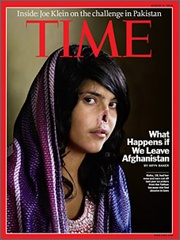
On the cover is a portrait of Aisha, an 18-year old Afghan woman who was ordered by the Taliban to have her nose and ears cut off because she ran away from her abusive in-laws.
On Time‘s website, managing editor Richard Stengel writes that it was not without reservation that he decided to include the picture of Aisha on the cover:
I’m acutely aware that this image will be seen by children, who will undoubtedly find it distressing. We have consulted with a number of child psychologists about its potential impact. Some think children are so used to seeing violence in the media that the image will have little effect, but others believe that children will find it very scary and distressing — that they will see it, as Dr. Michael Rich, director of the Center on Media and Child Health at Children’s Hospital Boston, said, as “a symbol of bad things that can happen to people.” I showed it to my two young sons, 9 and 12, who both immediately felt sorry for Aisha and asked why anyone would have done such harm to her.
This paragraph really resonated with me, because, in the wake of last month’s Face the Truth Tour, I’ve spent a fair amount of time these past few weeks responding to angry e-mails objecting to our displays of graphic abortion pictures in the public square — of which the most common complaint, by far, deals with the impact of the pictures on children.
Interestingly, Stengel’s rationale for showing the cover photo of Aisha’s mutilated face is substantially the same one we give in response to the related question we often receive.
Stengel goes on to say, “But bad things do happen to people, and it is part of our job to confront and explain them.”
This is, of course, the selfsame argument pro-lifers have been making for years about why we feel compelled to show graphic abortion pictures in the public square.
The Undeniable Power of Graphic Images
Think what you will about what prudential course the United States should pursue in regard to the war in Afghanistan. Indeed, Stengel disclaims, “We do not run this story or show this image either in support of the U.S. war effort or in opposition to it.”
But there is no denying the power of the image of Aisha’s mutilated face to illustrate the horrific truth about abuses perpetrated by the Taliban.
So too, there is no denying the power of the images of aborted babies to illustrate the horrific truth about the reality of abortion.
The obvious question to ask, then, is: If Time is not afraid to “confront” its readers with “distressing” graphic images of violence, why does it refuse to show pictures of aborted babies?
